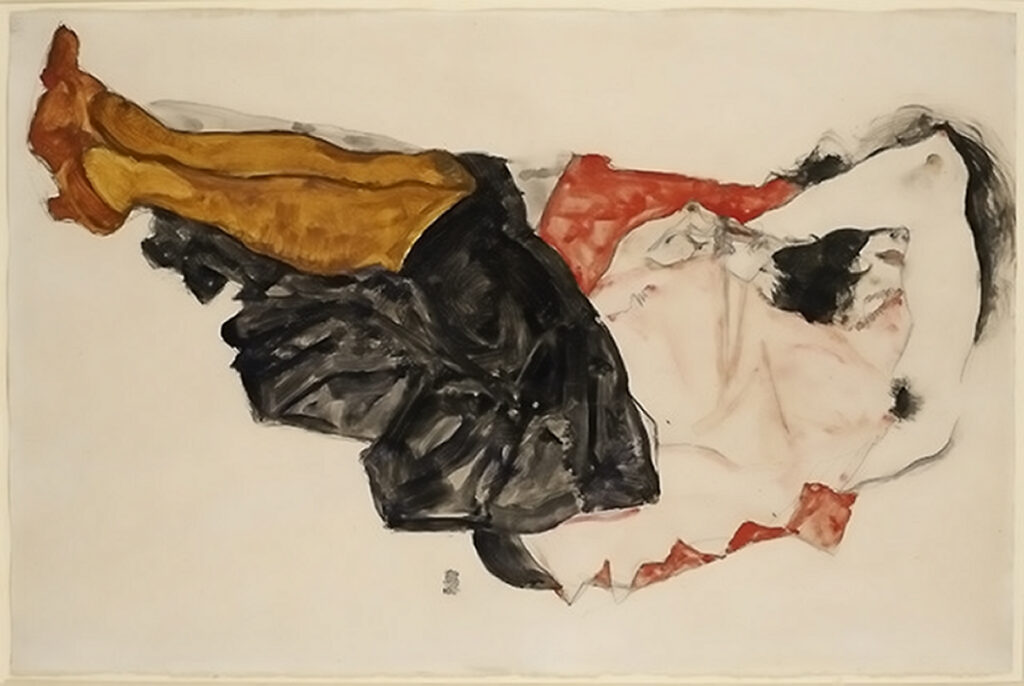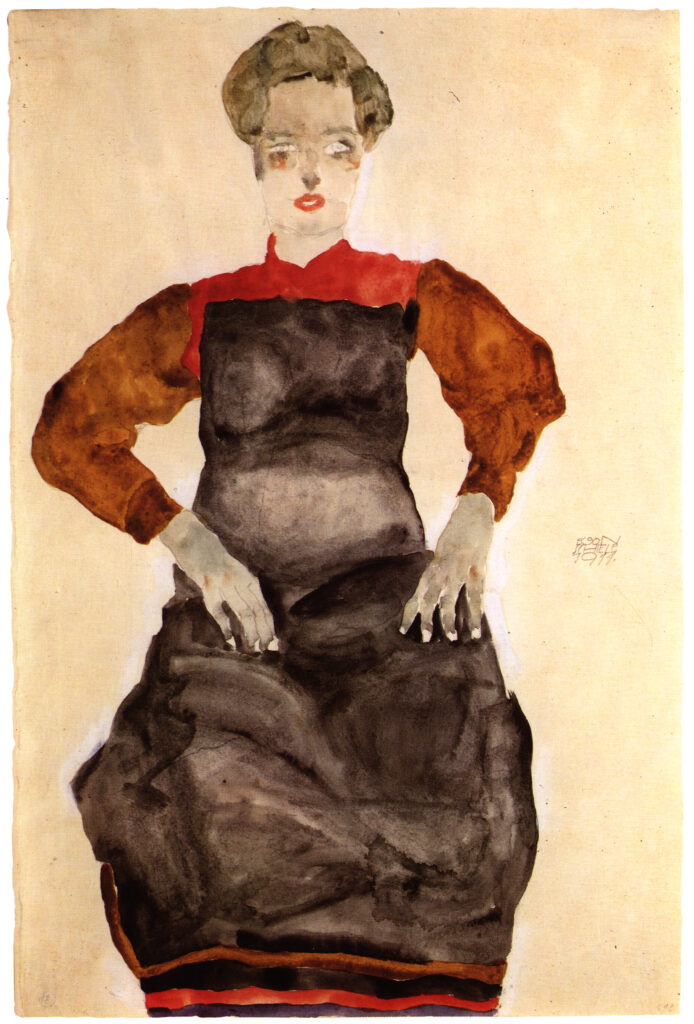PRESS RELEASE | NEW YORK |
IMPORTANT EGON SCHIELE WORKS ON PAPER IN 20TH CENTURY EVENING SALE
PROPERTY FROM THE COLLECTION OF THE VIENNESE CABARET AND FILM STAR, FRITZ GRÜNBAUM
LIVE AUCTION: 17 NOVEMBER 2022 at Rockefeller Center
New York— Christie’s is honored to include two important works on paper by Egon Schiele – formerly in the collection of the Viennese cabaret and film star Fritz Grünbaum – in the 20th Century Evening Sale taking place live on 17 November 2022 at Rockefeller Center. These two works trace Schiele’s development during 1911-1912, two crucial years in his brief career. The works were part of the collection numbering in the hundreds of works that Fritz Grünbaum – said to be the inspiration for Joel Gray’s character in the Broadway musical Cabaret – assembled in Vienna in the first decades of the last century. The collection was lost when the Nazis invaded Austria in the late 1930s, and both Mr. Grünbaum and his wife were sent to concentration camps where they perished. These two works were recently restituted to the Grünbaum family.
Frau, das Gesicht verbergend (estimate: $1,500,00-2,000,000)
Created in 1912, this work is notable for the unusual viewpoint and suggestively intimate pose of the sitter, and focuses on the sinuous form of the model as she twists on to her side and begins to remove her clothing under the artist’s watchful gaze. Although the sitter’s identity remains a mystery, her face hidden under the crook of her arm as she moves, the wild tangle of black hair falling loosely in a cloud around her is reminiscent of a series of portraits Schiele created of the bohemian dancer and mime artist Moa. Rejecting the traditional idealization of the female nude, and including the blemishes and anatomical quirks which marked the model’s body, this work captures the explosive modernity of Schiele’s vision during this period.
Frau mit schwarzer Schürze (estimate: $500,00-800,000)
Executed in delicate layers of pigment, Frau mit Schwarzer Schürze reveals Schiele’s growing confidence in the use of watercolor during the latter half of 1911. His art had undergone a dramatic transformation over the course of the previous year, shifting away from the bold, jagged, angular lines that had previously dominated his oeuvre to explore a softer, more delicate approach to form. In this work, Schiele allows the washes of color to bleed over the contours of his pencil drawing underneath, lending the outline of the figure a more rounded, organic character. Retaining a sense of the fluidity of the paint and the bold movements of the artist’s paintbrush as it danced across the page, Schiele plays with the sheer liquidity of the watercolor, limiting the flow of the pigment by adding a subtle white “halo” around the edges of the young girl’s body.
Vanessa Fusco, Head of Impressionist & Modern Art and Head of 20th Evening Sale, said: “These two exquisite works by Schiele display the daring nature of his ground-breaking studies of the female figure, an artistic obsession which occupied him throughout his short-lived career. Through his exacting and unforgiving investigation of the female body, the artist challenges and subverts the conservative veneer of contemporary Viennese society, revealing the latent erotic charge that existed just below its surface. This underlying tension, coupled with Schiele’s incredible command of his media, give these works a timeless quality that account for their enduring desirability and relevance.”
The Legacy of Fritz Grünbaum
Born Franz Friedrich Grünbaum in April 1880, Fritz Grünbaum was a celebrated cabaret performer, writer, actor and outspoken opponent of Nazism, active in Vienna during the early twentieth century. He studied law before turning to performance and cabaret, and enjoyed a highly successful and varied theatrical career, which included performances at the famous Viennese theatre Simpl, as well as roles in several early films. Alongside his work as a performer, Grünbaum held a life-long passion for art, shaped by his father Wilhelm’s activities as a dealer in the city of Brno (Brünn), and he built up a diverse personal collection which ranged from Russian icons and etchings by Old Masters such as Albrecht Dürer and Rembrandt, to Post-Impressionist and Modern drawings and watercolors by August Rodin, Camille Pissarro, Paul Signac, Max Liebermann, Käthe Kollwitz, and others.
However, it was compositions by the Viennese avant-garde of the early twentieth century and, in particular, the works of Egon Schiele that captured Grünbaum’s imagination. Over the course of his life, he purchased over 80 works by the artist, spanning the full range of Schiele’s creative output, from delicate pencil portraits and nude studies executed in gouache or watercolor, to striking, melancholic landscapes and mysterious allegorical subjects in oil.
Shortly after the German annexation of Austria in 1938, Grünbaum was arrested by the Gestapo and subsequently interned at Dachau concentration camp in June 1938, where he perished in January of 1941, after having also spent some time incarcerated in Buchenwald. His art collection, which numbered over 400 works at the time of his arrest, was lost following his wife Lilly’s deportation to the Maly Trostenets concentration camp near Minsk in October 1942, where she was murdered soon after her arrival. Frau, das Gesicht verbergend and Frau mit schwarzer Schürze were recently restituted to the Grünbaum family after years spent fighting for their return.
Richard Aronowitz, Christie’s Global Head of Restitution, said: “It is always deeply humbling to come face-to-face with works of art that were once owned by those people who went on to become victims of the Holocaust. These cherished items speak to us of lives lived and lost. Such is the case here with these two fine watercolor compositions by Egon Schiele: they stand as an abiding, unerasable testament to Fritz Grünbaum’s taste as a collector and to Egon Schiele at the height of his artistic powers.”
Christie’s has the largest and most experienced Restitution team of any international auction house, underscoring our responsibility to this field. Located in New York, London, Berlin, Brussels and Vienna, our researchers have a century of combined years of experience. We have made Nazi-era provenance research a hallmark of our expertise.
Images for press use available HERE.
PRESS CONTACT:
Edward Lewine | elewine@christies.com | 212 636 2680
About Christie’s
Founded in 1766, Christie’s is a world-leading art and luxury business. Renowned and trusted for its expert live and online auctions, as well as its bespoke private sales, Christie’s offers a full portfolio of global services to its clients, including art appraisal, art financing, international real estate and education. Christie’s has a physical presence in 46 countries, throughout the Americas, Europe, Middle East, and Asia Pacific, with flagship international sales hubs in New York, London, Hong Kong, Paris and Geneva. It also is the only international auction house authorized to hold sales in mainland China (Shanghai).
Christie’s auctions span more than 80 art and luxury categories, at price points ranging from $200 to over $100 million. In recent years, Christie’s has achieved the world record price for an artwork at auction (Leonardo da Vinci’s Salvador Mundi, 2017), for a single collection sale (the Collection of Peggy and David Rockefeller, 2018), and for a work by a living artist (Jeff Koons’ Rabbit, 2019).
Christie’s Private Sales offers a seamless service for buying and selling art, jewellery and watches outside of the auction calendar, working exclusively with Christie’s specialists at a client’s individual pace.
Recent innovations at Christie’s include the groundbreaking sale of the first NFT for a digital work of art ever offered at a major auction house (Beeple’s Everydays, March 2021), with the unprecedented acceptance of cryptocurrency as a means of payment. As an industry leader in digital innovation, Christie’s also continues to pioneer new technologies that are redefining the business of art, including the creation of viewing and bidding experiences that integrate augmented reality, global livestreaming, buy-now channels, and hybrid sales formats.
Christie’s is dedicated to advancing responsible culture throughout its business and communities worldwide, including achieving sustainability through net zero carbon emissions by 2030, and actively using its platform in the art world to amplify under-represented voices and support positive change.
Browse, bid, discover, and join us for the best of art and luxury at: www.christies.com or by downloading Christie’s apps.
The COVID-related re-opening status of our global locations is available here.

